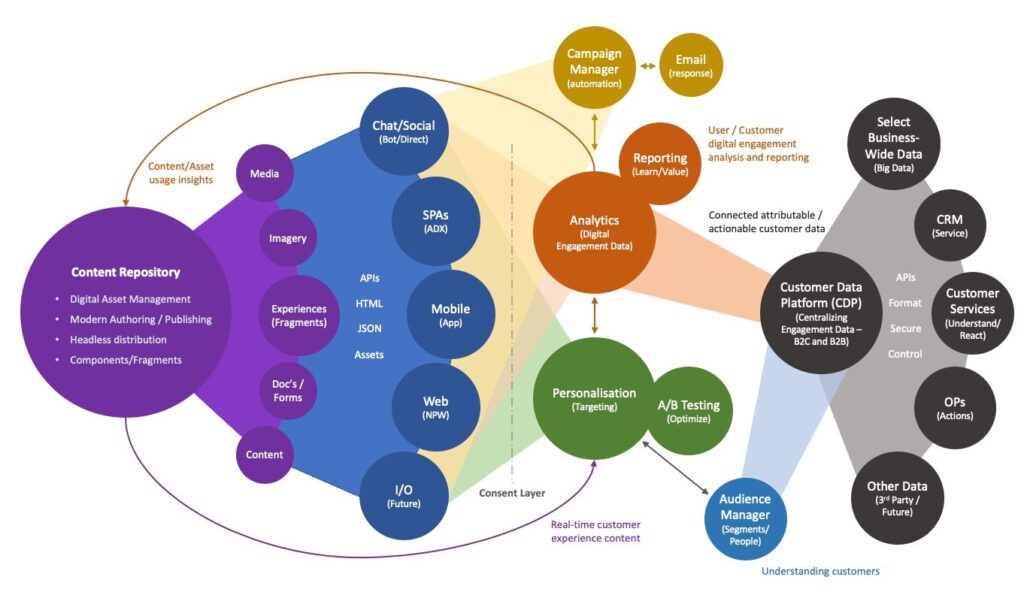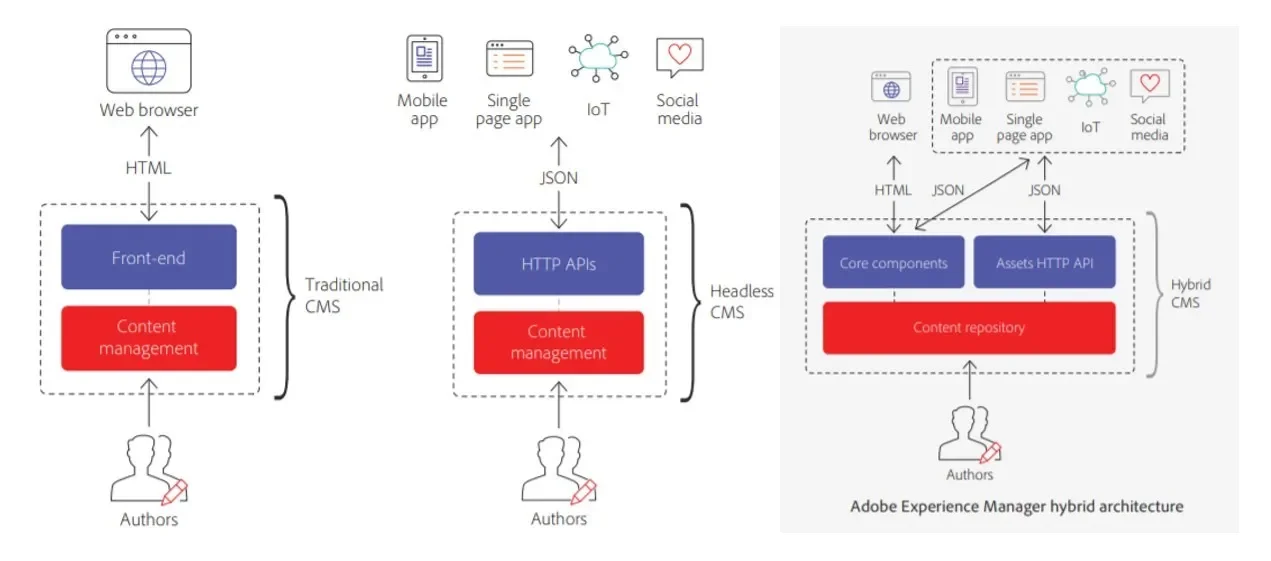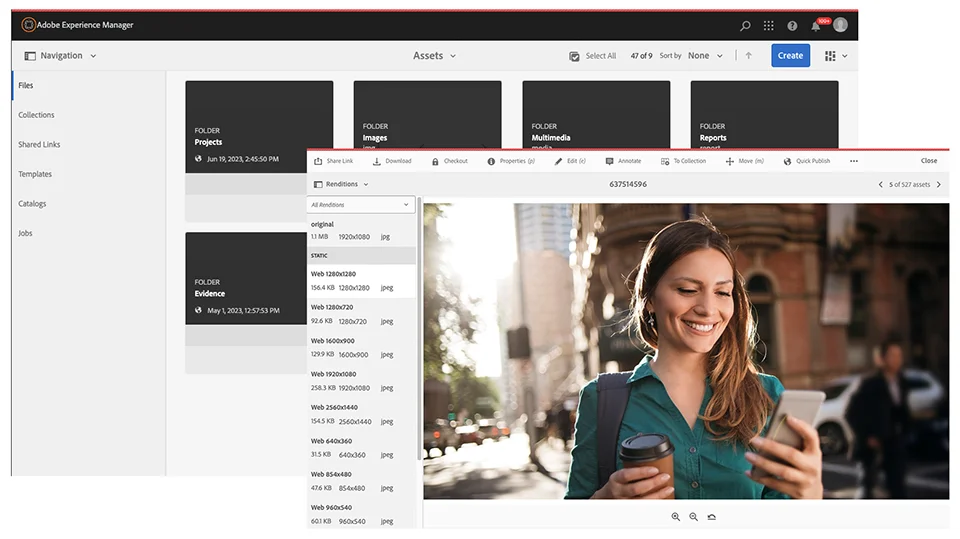Architecting a Unified Marketing Experience with Adobe AEM and Adobe Cloud Solutions
Improving the foundations to have better user centric design and user understanding.
As a seasoned digital engagement professional with a passion for empowering businesses through innovative technological solutions and user-centric-design methodologies, I was thrilled to lead the design and technology implementation of Adobe Experience Manager (AEM) and Adobe Marketing Cloud Solutions (AMS, Launch, Analytics and Target) for a leading UK financial services company. This project presented a unique challenge and opportunity – to transform the company’s marketing operations, enhance customer engagement, and drive conversation and retention.
The Challenge: A Fragmented Marketing Landscape
The company’s existing marketing platform was fragmented and outdated, lacking a true centralised hub for content management and automation. This hindered efficient content creation, delivery, and personalisation, ultimately impacting customer experience and campaign effectiveness. Additionally, the absence of single sign-on (SSO) integration caused inefficiencies in user group control and access and the lack of a proper analytics integration made it had to understand content usage. It was evident that a comprehensive solution was required to address these challenges and propel the company’s marketing strategy forward.
Top challenges:
- Poor user experience of AEM6.3/4 sites
- Technical debt (bad quality coding and documentation)
- Basic Workflows
- Inconsistent and inaccurate analytics
- Security and Regulatory risks
- Scalability / Upgradeability
- Multiple content duplication
- Inefficient content management
- Limited campaign capabilities
- Inconsistent across touch points
- Low digital standards
- Monitoring and Auditing time
- Inefficient environment architecture
The Solution: A Unified Marketing Platform
The implementation of the New Adobe AEM 6.5.x on AMS Environments and Adobe Marketing Cloud offered a transformative solution, empowering the company to streamline content management, deploy campaigns better, and enhance customer experiences. I spearheaded this project to renew the foundations, from establishing a clear roadmap to overseeing the detailed planning and execution phases. These foundations were used to build the 2023 website for the company and drive headless content for their secure platforms. It also set the foundations and standards for further content and hybrid digital experiences going forward.

Content and Journey Management: A Centralised Hub
AEM emerged as the central content management system (CMS), providing a single repository for storing, managing, and publishing marketing assets and journeys. This centralised approach eliminated the siloed environments and enabled efficient collaboration across teams. Greatly improving content re-use and content-usage insights. It was setup as a hybrid architecture to use the strengths of AEM in content distribution for multiple endpoints.

Custom Content Templates and Workflows
To streamline content creation and ensure consistency across all digital channels, I developed custom content template designs and workflow solutions, working with AEM Architects, Developers, Web Authors and Workshopped with all user groups and stakeholders to look at requirements, pain-points, and user experience. These workflows must have strict governance and risk controlled as well as full auditing for the Financial Services company. ‘Creation’ workflow templates standardised the content creation process, while the workflows automated repetitive tasks and ensured adherence to brand guidelines and strict regulatory requirements. The workflows were designed in Figma/Miro, built using the Adobe Coral UI design system and expanding components as needed to meet requirements while maintaining code standards for Adobe CI/CD quality gates on AMS and the companies own gates in Jenkins.

Features:
- Decentralised content management (from 6 to 200+ users).
- Integrated Email alerts and process statements from AEM inbox management
- Adobe Editable Template standards for easy change and maintenance without code release
- Code standards meeting Adobe and Companies CI/CD pipeline gates
- Training service and access groups for workflows
- UX/UI for workflows designed and based on user-centric-design methodologies
- Content controlled through environment stages
Foundations of components
Designed and worked with the developers to create new foundation reusable components based on the same level of standards and practises as the Adobe core components and in many cases extended the core components so that the new features and patches can be used on the foundation components as core components evolve and also allowed ability to interact with Adobe on component feature requests. These components fully compatible with the style system and the companies design system are fully W3C AA compliant and integrated into the data-layer event analytic standards. Best in class HTML5 and also best practises in authoring experience to allow authors to implement accessible content and layouts (example: semantic layout control). As the style system is separate from the components they can be reused in multiple brand states and are also in sync with component designs for the companies Angular platforms so CSS and Scripts can be shared further improving consistency and reduce production costs.
Featured non core-components designed:
- Video player (Analytics, Accessibility, API streaming service)
- Audio player (Analytics, Accessibility, API streaming service)
- PDF-Viewer Modal (Analytics, Accessibility, Document embed API)
- SPA Self-service support UI (Feed content from AEM pages for easy author)
- Modals (multiple requirements)
- Form inputs
- Navigation blocks
- Tables and Graphs (Accessible, Author-able, Responsive)
- Embed code (controlled code insert for prototyping in lower environments)
Integrated DAM and Fragments for Efficient Asset Management
I implemented the New DAM (Digital Asset Management) solution with AEM to facilitate efficient asset retrieval and management. This integration allowed marketers to easily locate and utilise relevant assets, enhancing content creation and delivery. Designed to deal with multiple sites, screens, headless content queries and content auditing/management with 1000’s of assets.

Implementation:
- Scalable DAM structure architecture design
- Tag usage (search, destination, segments, type) – tag management processes
- Content fragments (Hybrid usage with headless operations and in-page)
- Custom Coral UI components (example: locked-dates calendar)
- Smart Crop and Image Renditions over multiple folders
- Standardised filename conventions (some customer facing)
- Custom Metadata Schemas and Profiles (synced with workflows)
- GraphQL and API Query configurations (expose JSON/HTML securely)
- Enhanced reporting output with custom Excel/XML files for fast analysis
- Content insight analytics
- Automatic reporting (multiple report types)
- DAM workflows (Upload, Change, Publish, Destinations-headless etc.)
- Workflow gates that control quality (file types, size, metadata, naming, duplication)
- Workflow designs for video and audio assets
- Adobe Target Fragment usage APIs integration
- Bulk upload and change processes (large file counts)
Marketing Automation: Personalised Engagement
The combination of AEM and Target opened the door to sophisticated marketing automation capabilities. I integrated Target with AEM to trigger automated marketing campaigns based on specific actions or events on the AEM platform. This automation streamlined marketing efforts, ensuring timely and relevant messaging to target audiences. This used Experience Fragments through controlled workflows and also allowed for variant content and A/B testing the user experience.
Synchronised Customer Data for Personalised Marketing
To deliver personalised marketing experiences in secure platforms and mobile apps. I designed foundations for attributable customer data models so synchronisation can enable the delivery of targeted content via Launch and Target based on customer preferences and behaviours, enhancing customer engagement, and driving conversions in non-AEM environments. Synchronised segments and tag management in AEM was designed to control this ability.
SSO: Seamless AEM User Experience and Enhanced Security
To streamline user experience and strengthen security, I established SSO integration between AEM and the companies SSO/Identity and access manager. This integration enabled users to seamlessly sign in without repetitively entering their credentials and when a user leaves the company the system automatically removes access rights. This enhanced user experience not only improved convenience but also reduced the risk of unauthorised access and greatly improved auditing, monitoring, and user-group policy controls. Through this setup I could design and implement different gates and user-group policies that could be requested through internal request processes and control access with training level grades.
Analytics implementation
As owner of the Adobe Analytics implementation I sought to use the latest and best practises to get the best value from the solution. This meant using WebSDK through Launch and having a full SDR/Event tracking approach with Adobe Data-layer implementation in Web and SPA solutions. The foundations were setup so that it can be expanded to the companies following projects with simple reusable capabilities. As the AEM solution had the highest standards in component design they also had full adobe analytics integration so that user interaction data was right down to single component usage and scenario data. The 2023 company website had Analytics fully integrated to best in class standards which also included designing workspace usage for replay and analysis which had its own access and controls put in place. It was also implemented in the latest SPA platform solutions and plans to implement into mobile applications to get the widest customer and user insights.

Another feature of the Analytics used was its integration into AEM where content and page insights could be surfaced in the authoring experience so that content owners could see usage and other insights to help with there usage decisions.
Analytics features:
- Fully integrated Adobe Analytic in AEM and Target through Launch
- Best practise documentation and processes
- Integration with Angular SPA (phased approach)
- Content and Page analytical insights in AEM UI
- Reporting Mobile app for stakeholders
- Multiple custom workspaces for analysis and data visualisation
- GDPR integration compliant (opt-out by default)
- Designed to work with CDP integration
- Clean data strategy – no PII data in streams (detect, remove, report)
- Scalable foundations for many projects
- Data request triage processes
- Enhanced asset analytics (Video, Audio, Documents) – Understand asset value and user experience
CI/CD Pipeline integration and quality standards (Jenkins)
As the decision was made to use Adobe Managed Services (AMS) rather than on-premises or full Adobe AEM as a Cloud Service the CI/CD pipeline and environments needed to be setup to meet the companies processes and the Adobe standards. This was a complicated solution and required a lot of workshops to lead the directions with code was run through local CI/CD and then through Adobe CI/CD matching quality gates. This allowed to use the companies internal processes and code storage processes while still running through the correct Adobe processes so that the Quality of the output release was of the highest standards that previous on-premises solutions was not making.
Custom Workflows: Streamlined Operations and Reduced Manual Tasks
To further streamline operations and reduce manual tasks, I developed custom workflows for various processes. These workflows automated tasks such as content asset metadata management, renditions, reporting, and email alert triggering as well as scheduled processing events. This automation not only improved efficiency but also freed up time for marketers to focus on strategic initiatives rather than time consuming manual tasks.
The Impact: A Transformed Marketing Landscape
The implementation of Adobe AEM and Adobe Marketing Cloud Solutions delivered significant benefits for the company, transforming the marketing landscape and driving business growth:
- Enhanced Content Management and Automation: AEM provided a centralised CMS, enabling efficient content creation, publishing, and retrieval.
- Adobe Managed Services keeping everything optimum and maintained with active work on patch and update releases as well as performance and security monitoring
- Ability to migrate to Adobe AEM as a Cloud Service as everything built is configured to also work on that service
- Improved staff Experience: SSO integration ensured a seamless user experience across both AEM and Cloud Solutions, enhancing staff UX experience of the tools. Custom workflows streamlined operations, reducing response times, and improving customer satisfaction. Streamlined many marketing tasks and processes.
- Increased Marketing Effectiveness: Personalised marketing campaigns triggered by user behaviour on AEM led to improved campaign performance and targeted messaging abilities.
- Integration of Adobe Cloud Solutions to meet the companies goals of better understanding there customers and users and have the ability to provide personalised messaging and promotion.
- Highest digital standards set across journeys and assets
There was many more features and benefits as part of this foundations build and it is endless as new features and innovation is developed through AEM enhancements that can be easily implemented as the foundations are build to standards.
Conclusion: A Legacy of Innovation
The successful implementation of Adobe AEM 6.5.X, Adobe Managed Services and Adobe Marketing Cloud Solutions marked a significant milestone in the financial service company marketing journey. It transformed the way marketing campaigns were analyst, delivered, and personalised, ultimately enhancing customer experience, and driving business success. As the architect of this transformative initiative, I am proud to have played a pivotal role in empowering the company to embrace digital transformation and achieve marketing excellence. I truly believe I have made a difference to the user experience for both customers and the companies marketing teams.
The company if they wish can now move to then next stages of digital transformation with further integrations like Campaign management, Audience oversight, Customer Data Platform integration and AI integration as their business progresses into modern digital journeys and user experiences.
Shout out
As part of this project I led and worked with a lot of excellent people from the Web Team Manager, Project Manager, Digital Engagement Architects, AEM Architects, AEM Developers, Environment Operations, Change, Risk, Security, IT Delivery, Digital solutions, Vendor Management, Marketing Strategy stakeholders and external consultants including TCS. It was great that the CEO and CMO backed this shift in the Marketing Experience as it takes Executive buy-in for such shifts in culture and innovation.